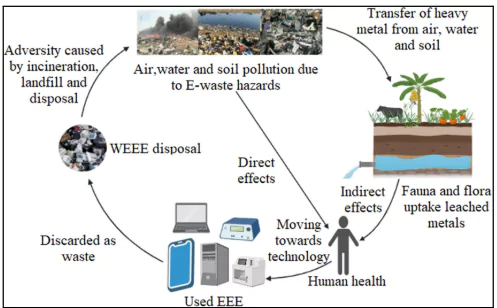
07-Jun-2025 11:00 AM
India’s E-Waste Crisis: Time to Rethink and Reform
📌 Context: A Modern Dilemma
India, with its rapid technological growth and digital revolution, is facing a serious environmental issue: electronic waste, or e-waste. As devices like smartphones, laptops, TVs, and household gadgets become obsolete faster, India now ranks as the third-largest generator of e-waste globally—behind only China and the United States.
What Is E-Waste?
E-waste refers to discarded electrical and electronic equipment (EEE). These are devices that are broken, outdated, or no longer wanted. The dramatic rise in usage of electronics has turned them into ticking time bombs when not disposed of properly.
From 2017-18 to 2023-24, India’s e-waste grew over 150%, from 7.08 lakh metric tonnes to 17.78 lakh metric tonnes.
That’s a huge environmental load—and one that India is currently ill-equipped to manage effectively.
The High Cost of Poor E-Waste Management
➤ Environmental Damage
Water Pollution: Harmful chemicals like cyanide and sulphuric acid seep into water bodies.
Air Pollution: Plastic burning and lead fumes pollute the air.
Soil Degradation: Toxic metals leach into the soil, impacting crops and biodiversity.
➤ Social and Health Hazards
Informal Recycling Sector: Around 95% of India’s e-waste is recycled informally, mostly by vulnerable groups, including women and children.
Health Risks: Workers are exposed to heavy metals without safety gear. Many don't live beyond their late 20s due to long-term exposure.
➤ Economic Losses
India loses ₹80,000 crore annually in recoverable metals like gold, copper, and rare earths.
The informal sector’s unregulated nature means an estimated $20 billion in potential tax revenue is lost every year.
Challenges Holding Us Back
No Consumer Incentives: There's little motivation for individuals to recycle electronics responsibly.
Weak Collection Network: Most towns and smaller cities lack authorized e-waste collection centers.
Unsafe Methods: Acid leaching, open burning, and manual dismantling continue in the informal sector.
Grey Market Imports: E-waste often enters the country disguised as “refurbished” or “donated” electronics.
Government Framework and Reforms
Extended Producer Responsibility (EPR)
Under EPR, producers and importers must take responsibility for collecting and recycling their products. The Central Pollution Control Board (CPCB) now operates a digital EPR portal for registration and tracking.
Policy Improvements
The government revised the E-Waste Management Rules in 2022.
India’s first e-waste clinic was opened in Bhopal, to collect and process waste from households and businesses.
Basel Convention
India is a signatory to the Basel Convention, a global treaty to regulate cross-border movement of hazardous waste and ensure eco-friendly disposal.
Conclusion: Turning Crisis into Opportunity
India's e-waste problem is more than just a waste issue—it’s a chance to create a green economy. Rather than simply managing waste, India must:
Recover valuable materials
Protect worker health
Build sustainable recycling infrastructure
Only then can we balance digital progress with ecological well-being as we strive for a Viksit Bharat (Developed India).
Multiple-Choice Questions (MCQs)
What is the rank of India in global e-waste generation?
a) 1st
b) 2nd
c) 3rd
d) 4th
✅ Answer: c) 3rd
What percentage of e-waste in India is handled by the informal sector?
a) 50%
b) 70%
c) 90–95%
d) 100%
✅ Answer: c) 90–95%
Which city houses India’s first e-waste clinic?
a) Mumbai
b) New Delhi
c) Bhopal
d) Hyderabad
✅ Answer: c) Bhopal
What is the main principle behind EPR (Extended Producer Responsibility)?
a) Consumers manage waste
b) Producers recycle their own products
c) Government funds recycling
d) NGOs handle waste
✅ Answer: b) Producers recycle their own products
What is one major chemical used in unsafe e-waste recycling?
a) Sodium chloride
b) Cyanide
c) Baking soda
d) Oxygen
✅ Answer: b) Cyanide